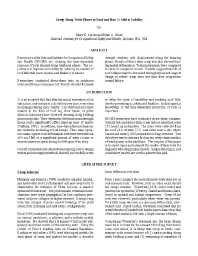Mining Publication: Creep Along Weak Planes in Roof and How It Affects Stability
Original creation date: March 2000
Researchers at the National Institute for Occupational Safety and Health (NIOSH) are studying the time-dependent response of rock stressed along weakness planes. The objective is to improve mine safety by reducing the number of roof falls that cause injuries and fatalities to miners. Researchers conducted direct-shear tests on mudstone overcored from a coal mine roof. Results showed frictional strength weakens with displacement along the shearing planes. Results of direct-shear creep tests also showed time-dependent deformation. Test measurements were compared to classical analytical models. Results suggest that risk of roof collapse may be decreased through layout and support design to reduce creep rates and thus slow progression toward failure.
Authors: MK Larson, RG Wade
Conference Paper - March 2000
NIOSHTIC2 Number: 20022767
Society for Mining Engineers Annual Meeting and Exhibit, 2000, Feb 29 Mar 1 Salt Lake City, UT Littleton, CO; :8 pp
See Also
- Development and Application of the Coal Mine Roof Rating (CMRR)
- Diagnosing and Controlling Moisture-Sensitive Roof in Coal Mines
- Effects of Far-Field Shearing Deformation on Fracturing Around an Underground Opening
- The Introduction of Roof Bolting to U.S. Underground Coal Mines (1948-1960): A Cautionary Tale
- Mistakes, Misconceptions, and Key Points Regarding Secondary Roof Support Systems
- Optimizing Secondary Roof Support with the NIOSH Support Technology Optimization Program (STOP)
- Overview of Coal Mine Ground Control Issues in the Illinois Basin
- Performance Characteristics for Welded Wire Screen Used for Surface Control in Underground Coal Mines
- Preventing Falls of Ground in Coal Mines With Exceptionally Low-Strength Roof: Two Case Studies
- Preventing Injuries Caused by Unrecognized Stone Mine Roof Beam Failures With a Pro-Active Roof Control Plan
- Page last reviewed: 9/21/2012
- Page last updated: 9/21/2012
- Content source: National Institute for Occupational Safety and Health, Mining Program


 ShareCompartir
ShareCompartir
